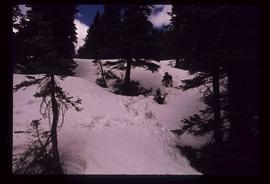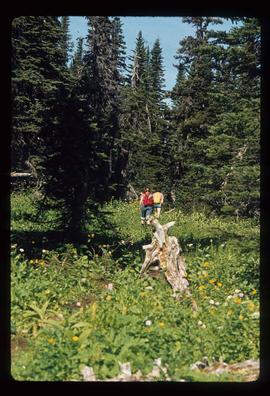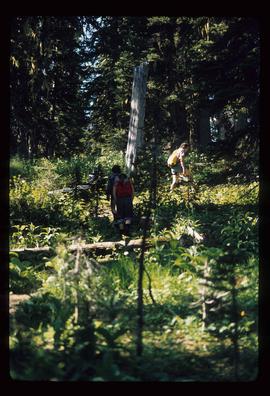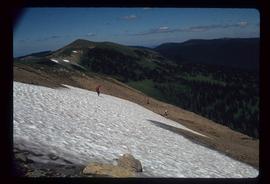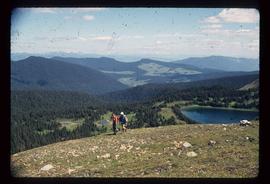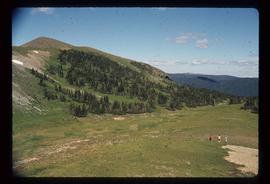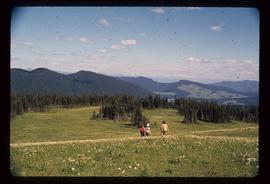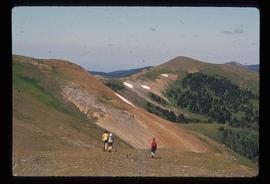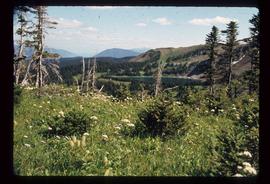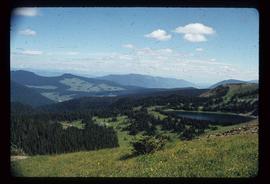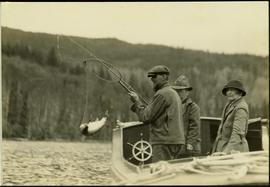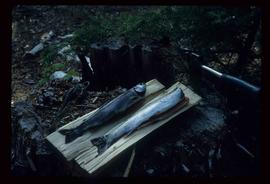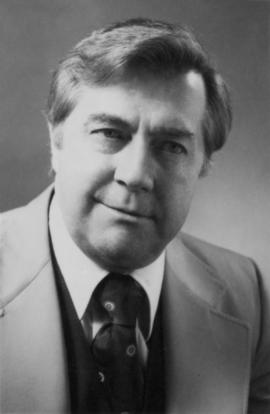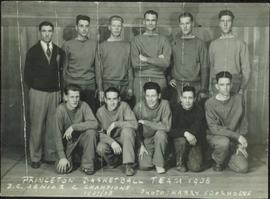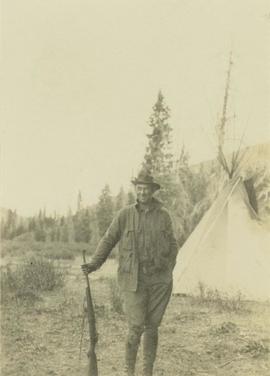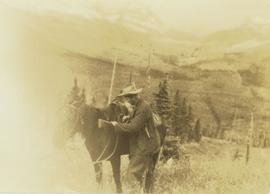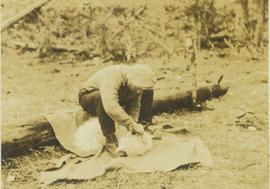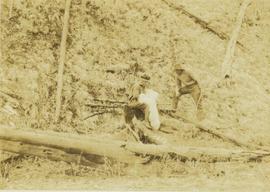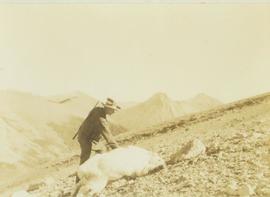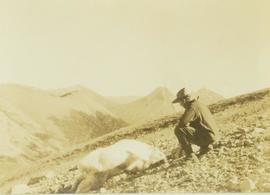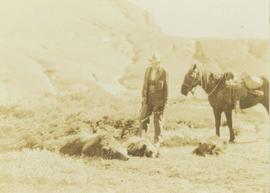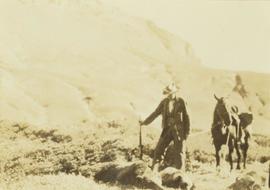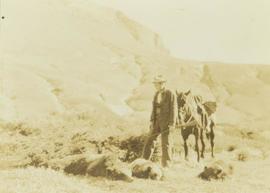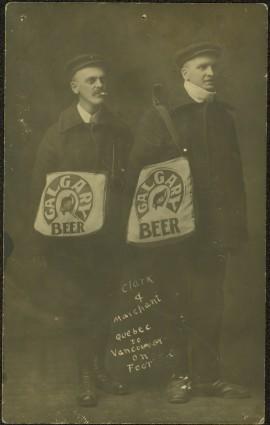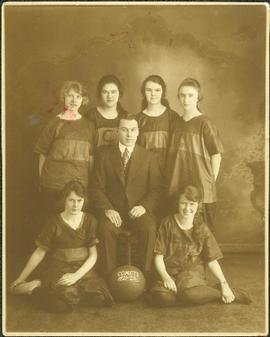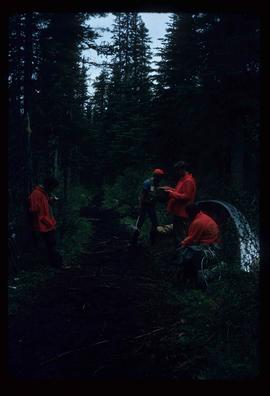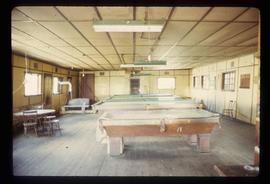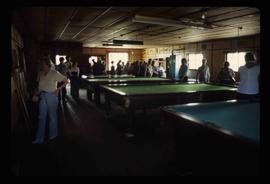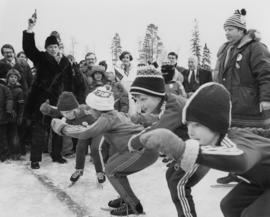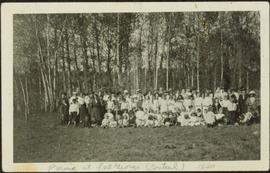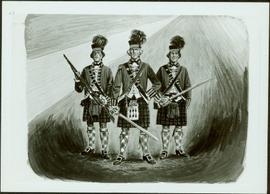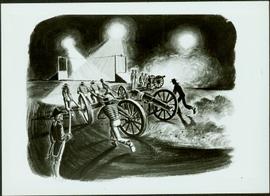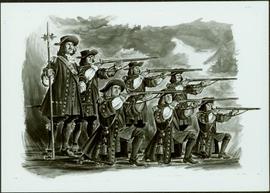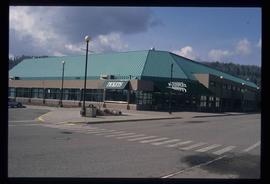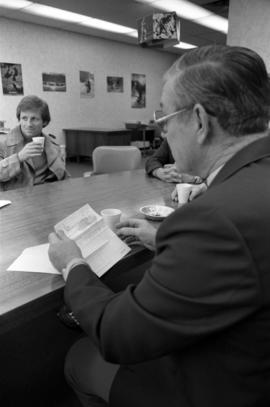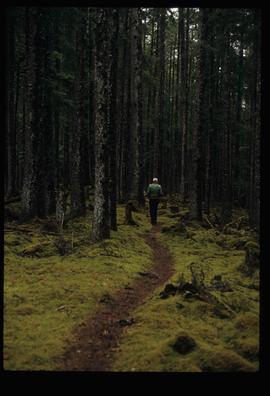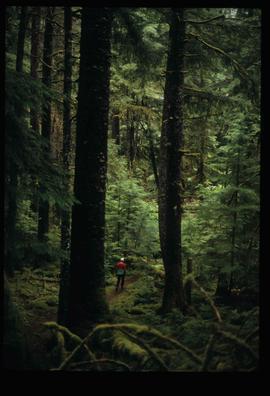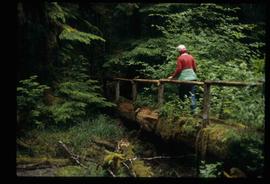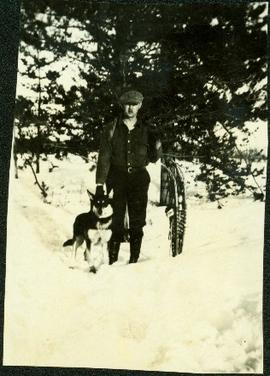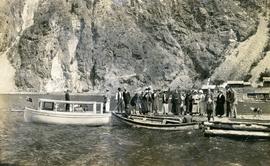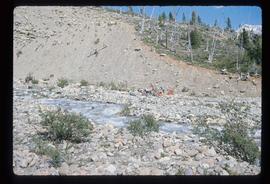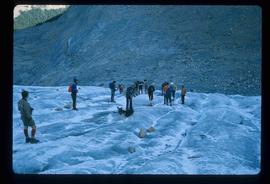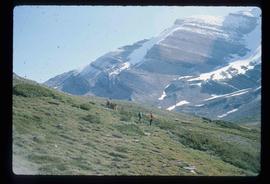Image depicts an individual sliding down a snowy trail somewhere Raven Peak.
Image depicts several individuals walking the Raven trail.
Image depicts several individuals walking the Raven trail.
Image depicts several individuals hiking in the area surrounding Raven Lake.
Image depicts several individuals hiking in the area surrounding Raven Lake; the lake is visible in the background.
Image depicts several individuals hiking in the area surrounding Raven Lake.
Image depicts several individuals hiking in the area surrounding Raven Lake.
Image depicts several individuals hiking in the area surrounding Raven Lake.
Image depicts a view of Raven Lake in the background.
Image depicts a view of Raven Lake and the surrounding area.
Typed annotation on recto: "Rainbow trout fishing in Stuart Lake near Douglas Lodge - B.C." Two men and one woman stand on boat with fishing gear, and a fish caught in net. Trees on hill in background. It is believed that Mr. and Mrs. Factor are present on the boat (see item 2004.6.28).
Image depicts a pair of Rainbow trout from Indianpoint Lake.
Typed annotation on recto: "Rainbow fishing - Stuart Lake, B.C." Two men in canoe with fishing gear, one man standing and holding fish. Logs or unidentified objects floating in water behind them, trees on shore in background.
Photograph depicts a portrait of R.A. (Alex) Fallow that was attached to his resume for Director of Loto Canada.
This Prize List, which was published by the Prince George Agricultural and Industrial Association incorporated with Prince George Horticultural Society, outlines the August 1943 Fall Fair rules and regulations, the prizes to be awarded; as well as a list of prize donors.
Item is a photograph of the 1938 Princeton Basketball Team which won the 1937-38 men’s B.C. Senior Championship. Ray Williston is third from the left in the front row.
Photograph depicts Prime Minister Pierre Trudeau, Evelyn Basso, and a man standing in a crowd at a Northern BC Winter Games event in Prince George.
Photograph depicts Prime Minister Pierre Trudeau and three women in a crowd at a Northern BC Winter Games event in Prince George.
Photograph depicts Prentiss Gray standing with a rifle in his hand in front of a teepee with a forested area in the background.
Photograph depicts Prentiss Gray standing with his rifle and horse in a grassy field. In the background a forested valley and snow-covered mountain range is visible.
Photograph depicts Prentiss Gray sitting on a log skinning his trophy mountain goat.
Photograph depicts Prentiss Gray sitting on a tree stump skinning his trophy mountain goat while Bruce Otto looks on.
Photograph depicts Prentiss Gray reaching out to a felled mountain goat lying on a rocky slope. In the background a mountain range is visible.
Photograph depicts Prentiss Gray standing beside a felled mountain goat on a rocky slope. In the background a mountain range is visible.
Photograph depicts a man who is probably Prentiss Gray standing over three felled grizzly bears. The man is holding onto the reins of a horse and a rifle while a mountain range rises up in the background.
Photograph depicts a man, probably Prentiss Gray, standing over three felled grizzly bears while holding the reins of his horse and a rifle. In the background a mountain side rises up in the distance.
Photograph depicts a man who is probably Prentiss Gray standing over three felled grizzly bears. The man is holding the reins of a horse while a mountain rises in the distance.
Photograph depicts two men posed with "CALGARY BEER" bags slung over shoulders. Handwritten annotation on verso of photograph: "Clark & Marchant Quebec to Vancouver on Foot", on recto: "To H F Glassey With Every Good wish. from Leo Marchant. Pearson's Magazine 1909."
Violet stands second from left among group of six girls wearing uniforms, posed in front of backdrop. Two sit on floor, and four stand behind their coach, who is seated in a chair and wearing a suit. A basketball sits between his feet, painted with "COMETS 1921-1922". Violet's shirt has a letter "C" on its front. This photograph was taken in Prince Rupert where Violet attended high school while living with her relatives Sarah and Herbert Glassey.
Image depicts the canoe group portaging to Indianpoint Lake.
Image depicts an old pool hall somewhere in Wells, B.C.
Image depicts an old pool hall, crowded with unknown individuals, somewhere in Wells, B.C.
Photograph depicts Pierre Trudeau firing a starting pistol at a children's speed skating event during the 1978 Northern BC Winter Games. Iona Campagnolo, Ron Bassford and an unidentified crowd watch four children crouch at the starting line.
Photograph depicts a large group of women, men, and children standing and sitting on grass. Stand of trees crosses midground, forest visible in background. Handwritten annotation on verso of photograph: "Picnic at Fort George (Central) 1920." Photograph believed to have been taken at current location of Spruceland Shopping Center.
Photograph depicts the a painting of three men in the Royal Highland military uniforms. Typed annotation glued to verso of photograph provides an interpretation of this piece of art: "The 42nd (Royal Highland) Regiment of Foot - 1782. The first battalion of this British regiment arrived in New York in 1756. After serving in numerous campaigns and engagements in North America, the 42nd (Royal Highland) Regiment of Foot garrisoned in Nova Scotia. It is from this famous regiment that the Black Watch (Royal Highland) Regiment of Canada derives its name and much of its colorful dress and traditions."; "Le 42nd (Royal Highland) Regiment of Foot - 1782. Le premier bataillon de ce régiment britannique arriva à New-York en 1756. Après plusieurs campagnes en Amérique du Nord, il fit garnison en Nouvelle-Ecosse. C'est de ce fameux régiment que s'inspirent les uniformes et les traditions du Black Watch (Royal Highland) Regiment of Canada. Cornemuses et tambours y ont toujours joué un rôle important et pittoresque."
Photograph depicts a painting of a naval gun race with men in striped shirts pulling canons and an onlooking officer in uniform. Typed annotation glued to verso of photograph provides an interpretation of this piece of art: "Course de canons de la Marine. Deux équipes, en costumes de la Marine de 1812, réalisent une variante sensationnelle de la course de canons traditionnelle de la Marine. Elles doivent démanteler complètement les canons antiques, les porter en une course d'obstacles difficile et les réassembler pour faire feu. Il faut du courage, du muscle, et des mois d'entraînement."; "Naval gun race. Two teams in naval costumes of 1812 stage a thrilling variation on the traditional naval gun race. They must completely dismantle the antique cannons, carry them over a grueling obstacle course and reassemble the guns for firing. It takes courage, muscle and months of training."
Photograph depicts a painting of a battle regiment consisting of six men holding rifles and one man looking on. Typed annotation glued to verso of photograph reads: "Le Régiment de Carignan-Salières - 1665. This famous regiment was dispatched to Canada (then called New France) by King Louis XIV and disembarked from its small sailing vessels on eastern shores in the spring of 1665. Historically it was an important event. Until then, the colonists had been obliged to provide their own defence and the French regiment was the first military protection they enjoyed."; "Le Régiment de Carignan-Salières - 1665. Ce fameux régiment fut envoyé au Canada (appelé alors Nouvelle-France) par Louis XIV. Au printemps de 1665, il débarquait sur les rivages de l'est. Jusque-là, les colons avaient dû se défendre par leurs propres moyens; c'était la première protection militaire qui leur était offerte. L'arrivée des troupes régulières ramenèrent l'espoir aux colons découragés."
Image depicts the Prince George Multiplex.
Photograph depicts a portrait of Peter Lester that was attached to his resume for Director of Loto Canada.
Photograph depicts Peter Jones sitting at a table with organizers of the Northern BC Winter Games in Smithers.
Image depicts an individual walking on a path through a forest somewhere on Haida Gwaii.
Image depicts an individual walking on a path through a forest somewhere on Haida Gwaii.
Image depicts an individual walking on a a log bridge in a forest somewhere on Haida Gwaii.
Percy Garland (married Ellen Taylor) stands with snowshoes and Husky dog in snowy area in front of two trees.
Photograph depicts a group of men, women, and children on the dock at the east end of Seton Lake. Two boats are docked, awaiting passengers. Another group of people are seated in a third boat on the far side of the dock. In the background, the PGE railway grade is visible, dating this photograph on or after 1915. The Seton Lake sawmill is also visible in the background.
Image depicts a group of people on the rocky bank of a river somewhere near Mt. Robson.
Image depicts a group of people standing on the foot of a glacier, possibly the Robson Glacier.
Image depicts a group of people standing on the foot of a glacier, possibly the Robson Glacier.
Image depicts a group of people standing on a hill, with what is possibly Mt. Robson in the background.
